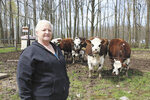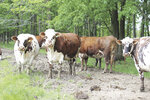

ARPIN, Wis. — Rhonda Treml-Knebel grew up in a world of black and white. But for nearly 20 years, she has been seeing things in shades of red, falling for the Normande cow and everything they have to offer.
“I was at World Dairy Expo, walking around and I happened to see the Normande grazing exhibit there, and they looked like the cattle I remembered — strong and healthy — and they were extremely pretty, as far as their color,” Treml-Knebel said. “I went home and read the literature I had picked up, then I did some more research online. The more I read and learned, the more interested I became.”
A life-long Holstein breeder, Treml-Knebel said she had become disenfranchised with the direction the breed was taking. With their children grown, Treml-Knebel and her husband, Bill, decided to sell their herd but retain a few heifers.
“Holsteins were beginning to go downhill as far as health and sustainability, in my eyes,” Treml-Knebel said. “They were needing huge amounts of feed and not doing well as grazers. I just wasn’t happy with that.”
The dual-purpose Normande breed hails from the Normandy- Bretagne region of Northwest France, and they are noted for having excellent feet and legs and good health traits. Normande meat and milk are considered superior in their native country, Treml-Knebel said. The best cuts of Normande beef come from cows that are 5-6 years old, she said.
“Restaurants that display the Normande logo are the expensive ones,” Treml-Knebel said. “They market their cattle from cradle to grave. There is information about every aspect of an animal’s life on the label – the breed, how old the animal was, information about how they were fed and raised.”
After that initial exposure to the breed, the idea of owning Normande cattle remained in the back of Treml-Knebel’s mind, and then, one day, she received a phone call from a friend asking her to haul some animals.
“After becoming interested in the breed as well, my friend had found a lady who was needing to sell her Normandes for health reasons and she was going to buy a heifer,” Treml-Knebel said. “Barb brought home Rosie, and I brought home Bridget, Celeste and Daphne and a little bull calf.”
Treml-Knebel said she had some explaining to do to her husband, when she pulled in the yard with a trailer full of Normandes, but he has come to love the breed as well.
“That is how it all started – with those three heifers,” Treml-Knebel said. “I started breeding them from there and started breeding my Holstein heifers to Normande as well.”
Today the Knebels maintain a small herd of five milking Normandes, along with youngstock and bulls, from which they actively market genetics. They use the milk for their own purposes and give milk away to dog breeders in the area for pet milk. They also market beef from their animals.
Since those first three heifers came to live on Treml-Knebel’s farm, she has embraced the breed. The journey, however, has not always been an easy one.
Availability of purebred Normande semen is limited in the U.S., as are opportunities to purchase full-blooded Normande females, Treml-Knebel said. Importation restrictions on semen and embryos due to outbreaks of diseases have added to the difficulty of bringing purebred genetics from France to the U.S.
“People want them,” Treml-Knebel said. “There’s just not a lot of them around. I have sold cattle and embryos to people all around the country.”
Looking to expand their herd and marketing opportunities, the Knebels have twice traveled to France in pursuit of building their Normande herd.
In 2005, they worked with a brokerage company to import 40 purebred embryos from France. The results were disappointing, as only two live calves were born from that shipment. The Knebels made another attempt at organizing a purchase of embryos in 2007, working directly with French farmers. This yielded better results: 18 live births from 20 embryos.
Over 4,000 Normandes are in the U.S. with over 500 head registered with the U.S. Normande Breeders Organization, which Treml-Knebel helped to found. The organization was established to fill a need for accurately coded registrations for embryo and semen marketing.
“A lot of people don’t register them here,” Treml-Knebel said. “Many don’t realize they can register them even if they are a percentage. The breed is growing in popularity because they are so hardy and so versatile.”
Globally, the Normande breed is more prevalent, with over a million Normandes in France. The largest population of the breed is in Colombia, with 1.8 million documented through the government registry. Treml-Knebel was recently invited to represent the USNBO at the 80th anniversary celebration of Normande in Colombia later this fall.
Normande cattle’s hardy characteristics are what made Treml-Knebel like the breed nearly 20 years ago, and the same ones that drive her passion today.
“Everybody loves their Normandes, and it’s not hard to understand why,” Treml-Knebel said. “They are so self-sufficient, so tough. They love to be outside, even in the winter. They are just solid, sturdy, beautiful cows.”
Comments
No comments on this item Please log in to comment by clicking here